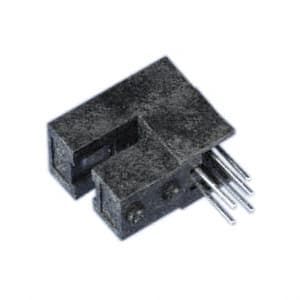Viz Specifikace pro podrobnosti o produktu.

GP1A71R
Product Overview
Category
The GP1A71R belongs to the category of optical sensors.
Use
It is commonly used for detecting the presence or absence of an object by using an infrared emitting diode and a phototransistor.
Characteristics
- Utilizes infrared light for detection
- Compact and versatile design
- High sensitivity and reliability
Package
The GP1A71R is typically available in a small, surface-mount package.
Essence
This sensor is essential for applications requiring precise object detection and proximity sensing.
Packaging/Quantity
It is usually packaged in reels and available in varying quantities based on customer requirements.
Specifications
- Operating Wavelength: 950 nm
- Collector-Emitter Voltage: 35 V
- Collector Current: 20 mA
- Power Dissipation: 70 mW
- Operating Temperature Range: -25°C to +85°C
Detailed Pin Configuration
The GP1A71R has a standard 4-pin configuration: 1. Anode of Infrared Emitting Diode 2. Cathode of Infrared Emitting Diode 3. Collector of Phototransistor 4. Emitter of Phototransistor
Functional Features
- High-speed response
- Low profile package
- Suitable for reflow soldering
Advantages and Disadvantages
Advantages
- Reliable object detection
- Compact design
- Versatile application possibilities
Disadvantages
- Limited range for object detection
- Susceptible to ambient light interference
Working Principles
The GP1A71R operates based on the principle of modulated infrared light detection. When an object comes within the detection range, it obstructs the infrared light emitted by the diode, causing a change in the phototransistor's conductivity, which is then detected as the presence of the object.
Detailed Application Field Plans
The GP1A71R is widely used in various applications, including: - Proximity sensing in automated equipment - Object detection in robotics - Paper detection in printers and copiers - Position sensing in motor control systems
Detailed and Complete Alternative Models
Some alternative models to the GP1A71R include: - GP1A73A - GP1A75E - GP1A76A
In conclusion, the GP1A71R optical sensor offers reliable and compact object detection capabilities, making it suitable for a wide range of applications in different industries.
Word Count: 332
Seznam 10 běžných otázek a odpovědí souvisejících s aplikací GP1A71R v technických řešeních
What is GP1A71R?
- GP1A71R is a reflective photointerrupter, which consists of an infrared emitting diode and a NPN silicon phototransistor.
What are the typical applications of GP1A71R?
- GP1A71R is commonly used in printers, copiers, vending machines, and industrial automation equipment for paper detection, edge sensing, and position sensing.
What is the operating voltage range of GP1A71R?
- The operating voltage range of GP1A71R is typically 4.5V to 5.5V.
How does GP1A71R function as a paper sensor in printers?
- GP1A71R emits infrared light, and when paper passes between the emitter and detector, the reflected light is interrupted, signaling the presence of paper.
Can GP1A71R be used for precise edge detection in industrial equipment?
- Yes, GP1A71R's high sensitivity and compact size make it suitable for precise edge detection in various industrial equipment.
What is the response time of GP1A71R?
- The typical response time of GP1A71R is in the range of microseconds, making it suitable for high-speed applications.
Is GP1A71R resistant to ambient light interference?
- Yes, GP1A71R has built-in ambient light rejection, which minimizes the impact of external light sources.
Can GP1A71R be used in harsh environmental conditions?
- GP1A71R is designed to operate reliably in a wide temperature range and is suitable for use in harsh industrial environments.
What are the key advantages of using GP1A71R in technical solutions?
- Some advantages include its small form factor, high reliability, and low power consumption, making it ideal for integration into various technical solutions.
Are there any specific precautions to consider when integrating GP1A71R into a design?
- It's important to ensure proper alignment and mounting of GP1A71R to maintain accurate sensing performance. Additionally, attention should be given to electrical connections and signal conditioning for optimal functionality.

